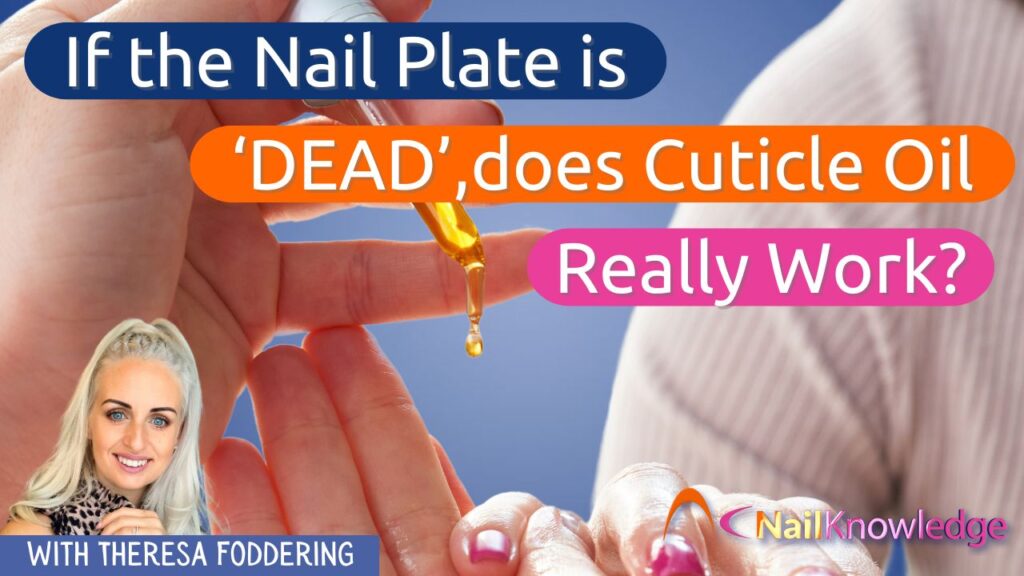Nos lo preguntan a menudo: “If the nail plate is ‘dead,’ does cuticle oil really work?” It’s a valid question, and the terminology floating around online can often be confusing or misleading. The truth is, while the nail plate is made of dead keratinised cells, that doesn’t mean it doesn’t benefit from proper care.
Así que permíteme que te aclare las cosas y te dé mis mejores consejos sobre por qué los aceites de uñas son esenciales y cómo funcionan realmente.
Nails Are ‘Dead,’ But That Doesn’t Make Them Immune to Damage
It’s true that the nail plate is composed of dead, keratinised cells. However, the fact that it’s ‘dead’ tissue doesn’t mean it’s unaffected by day-to-day life. Think of your hair—also ‘dead’ keratinised cells. We still shampoo, condición, and even apply masks and oils to moisturise – to improve its look, feel, and resilience. The same applies to our nail plates. They might not be “alive,” but they can still become dry, brittle, and prone to breakage due to environmental factors, repeated chemical exposure, or just everyday wear and tear.
¿Qué es la cutícula y qué es la lámina ungueal?
La cutícula: The cuticle is a thin layer of dead, very sticky skin cells produced by the eponychium hitching a ride out along with the growing nail plate, forming a protective seal at the base of the nail. While important as a barrier, this non-living tissue can be safely removed or softened and gently lifted during professional services to prevent the lifting of nail coatings and to keep the area aesthetically tidy.
La placa de la uña: The nail plate itself is a stack of flattened, keratinised cells that emerge from the matrix. Although it’s ‘dead’ tissue, it still thrives when it’s maintained at an optimal moisture and oil balance. This condition makes it stronger, more flexible, and less likely to peel or crack.
From ‘Cuticle Oil’ to ‘Nail & Skin Oil’
Many top brands have moved away from calling it “cuticle oil” and now refer to it as “Nail & Skin Oil.” I’m quite passionate about this language evolution. This shift in terminology is more than just marketing. It recognises that the true value is in hydrating and protecting both the nail plate and the surrounding living skin structures—such as the lateral nail folds, the proximal nail fold (PNF), and the hyponychium. These areas are very much alive and form essential protective seals that help guard the delicate matrix where the nail is formed and grows.
In truth, we remove the actual cuticle (which is non-living, sticky tissue that forms an important seal), so moisturising the “cuticle” itself doesn’t make sense. Instead, we focus on conditioning the living skin around the nail and the nail plate itself, maintaining a healthier, more flexible, and less damage-prone environment.
Cómo penetran y protegen determinados aceites
Not all oils are created equal. Some, like jojoba and avocado oil, contain smaller or more elongated molecular structures that can penetrate more easily into the superficial layers of the nail plate and the surrounding skin. They won’t dive deeply into the centre of the nail plate the way water might seep into a sponge, but they can and do move into the upper layers with repetitive application. This penetration helps lock in moisture, providing flexibility and protection against brittleness and breakage.
Tocopherol (vitamin E) molecules, on the other hand, are larger and struggle to fully penetrate on their own. However, they’re still incredibly beneficial. When blended with natural oils, tocopherol can “hitch a ride,” allowing some of it to settle just beneath the surface. This is actually where it’s needed most—to provide antioxidant protection near the nail’s surface, helping safeguard against discolouration, UV damage, and brittleness over time.
Tres categorías clave de hidratación
Emollients, humectants, and occlusives are three categories of moisturising ingredients that work together to maintain healthy nails and skin. Emollients help smooth and soften by filling in tiny gaps between cells, improving flexibility and texture. Humectants draw moisture into the nail plate and surrounding skin, ensuring it remains hydrated. Occlusives create a protective barrier that seals in this moisture, preventing it from escaping too quickly and shielding against environmental stressors. High-quality nail and skin oils often contain a blend of these ingredient types to provide a balanced approach—nourishing the nail plate, maintaining the skin’s integrity, and promoting a well-hydrated, resilient surface.
- Emolientes: Alisan y suavizan rellenando pequeños huecos entre las células, mejorando la flexibilidad y la textura.
Examples: Jojoba oil, Avocado oil, Almond oil, Squalene - Humectantes: Aportan humedad a la placa ungueal y a la piel circundante, garantizando que se mantengan bien hidratadas.
Examples: Glycerin, Hyaluronic acid, - Oclusivas: Crean una barrera protectora que retiene la humedad, impidiendo que se escape y protegiendo contra los factores ambientales.
Examples: Lanolin, Shea butter, Petroleum Jelly, Cocoa Butter
¿Por qué utilizar aceites acondicionadores?
Conditioning oils don’t just sit on top; they help create a more flexible, impact-resistant environment. This flexibility reduces the chance of breakage and can improve the longevity of your manicure, whether you wear polish, gel, enhancements, or just go Au Natural. Furthermore, the oils help maintain the health of the surrounding skin, encouraging proper barrier function, reducing hangnails, and promoting an overall healthier nail unit.
In other words, while the nail plate isn’t alive, it’s still receptive to what you apply. These targeted oils enhance appearance, support durability, and protect against external stresses. When combined with regular use, you create a consistent layer of defence—like conditioning your hair regularly so it stays shiny, flexible, and resilient.
En conclusión:
- Yes, the nail plate is ‘dead’—but it still benefits from oils to maintain flexibility and prevent damage.
- ‘Nail & Skin Oil’ is a more accurate term than ‘cuticle oil’ because we focus on living skin around the nail and the nail plate itself, not the removable cuticle.
- Certain oils, like jojoba and avocado, do penetrate and condition the nail’s top layers and surrounding skin. Tocopherol (vitamin E), especially when carried by these oils, protects and prevents unwanted chemical reactions at or near the surface.


